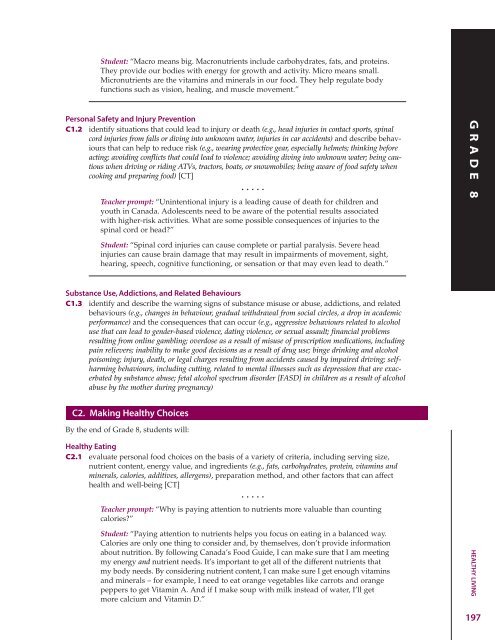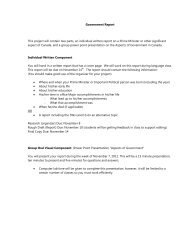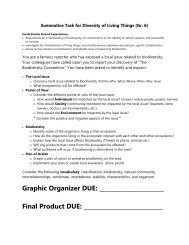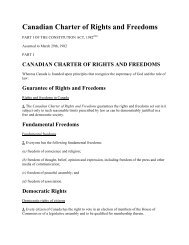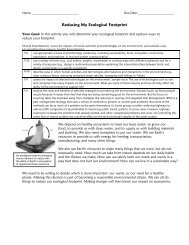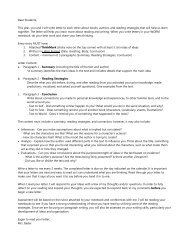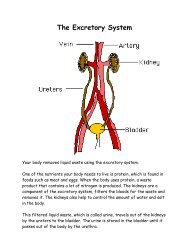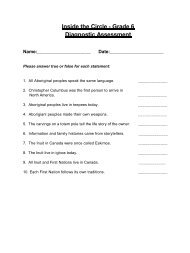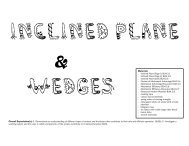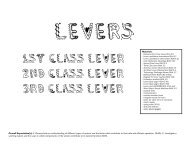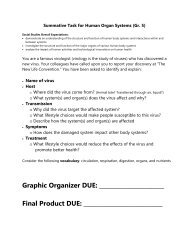Grade 8 Health Curriculum - Mrs. Bader's Classroom
Grade 8 Health Curriculum - Mrs. Bader's Classroom
Grade 8 Health Curriculum - Mrs. Bader's Classroom
Create successful ePaper yourself
Turn your PDF publications into a flip-book with our unique Google optimized e-Paper software.
Student: “Macro means big. Macronutrients include carbohydrates, fats, and proteins.<br />
They provide our bodies with energy for growth and activity. Micro means small.<br />
Micronutrients are the vitamins and minerals in our food. They help regulate body<br />
functions such as vision, healing, and muscle movement.”<br />
Personal Safety and Injury Prevention<br />
C1.2 identify situations that could lead to injury or death (e.g., head injuries in contact sports, spinal<br />
cord injuries from falls or diving into unknown water, injuries in car accidents) and describe behaviours<br />
that can help to reduce risk (e.g., wearing protective gear, especially helmets; thinking before<br />
acting; avoiding conflicts that could lead to violence; avoiding diving into unknown water; being cautious<br />
when driving or riding ATVs, tractors, boats, or snowmobiles; being aware of food safety when<br />
cooking and preparing food) [CT]<br />
• • • • •<br />
Teacher prompt: “Unintentional injury is a leading cause of death for children and<br />
youth in Canada. Adolescents need to be aware of the potential results associated<br />
with higher-risk activities. What are some possible consequences of injuries to the<br />
spinal cord or head?”<br />
Student: “Spinal cord injuries can cause complete or partial paralysis. Severe head<br />
injuries can cause brain damage that may result in impairments of movement, sight,<br />
hearing, speech, cognitive functioning, or sensation or that may even lead to death.”<br />
Substance Use, Addictions, and Related Behaviours<br />
C1.3 identify and describe the warning signs of substance misuse or abuse, addictions, and related<br />
behaviours (e.g., changes in behaviour, gradual withdrawal from social circles, a drop in academic<br />
performance) and the consequences that can occur (e.g., aggressive behaviours related to alcohol<br />
use that can lead to gender-based violence, dating violence, or sexual assault; financial problems<br />
resulting from online gambling; overdose as a result of misuse of prescription medications, including<br />
pain relievers; inability to make good decisions as a result of drug use; binge drinking and alcohol<br />
poisoning; injury, death, or legal charges resulting from accidents caused by impaired driving; selfharming<br />
behaviours, including cutting, related to mental illnesses such as depression that are exacerbated<br />
by substance abuse; fetal alcohol spectrum disorder [FASD] in children as a result of alcohol<br />
abuse by the mother during pregnancy)<br />
C2. Making <strong>Health</strong>y Choices<br />
By the end of <strong>Grade</strong> 8, students will:<br />
<strong>Health</strong>y Eating<br />
C2.1 evaluate personal food choices on the basis of a variety of criteria, including serving size,<br />
nutrient content, energy value, and ingredients (e.g., fats, carbohydrates, protein, vitamins and<br />
minerals, calories, additives, allergens), preparation method, and other factors that can affect<br />
health and well-being [CT]<br />
• • • • •<br />
Teacher prompt: “Why is paying attention to nutrients more valuable than counting<br />
calories?”<br />
Student: “Paying attention to nutrients helps you focus on eating in a balanced way.<br />
Calories are only one thing to consider and, by themselves, don’t provide information<br />
about nutrition. By following Canada’s Food Guide, I can make sure that I am meeting<br />
my energy and nutrient needs. It’s important to get all of the different nutrients that<br />
my body needs. By considering nutrient content, I can make sure I get enough vitamins<br />
and minerals – for example, I need to eat orange vegetables like carrots and orange<br />
peppers to get Vitamin A. And if I make soup with milk instead of water, I’ll get<br />
more calcium and Vitamin D.”<br />
G R A D E 8<br />
HEALTHY LIVING<br />
197


